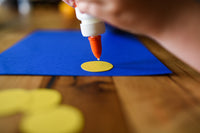By Bridget Parmenter
When I was a mom of a very busy 3 year old and 18 month old, I was laid off from my early childhood teaching job. As a result, I found myself using my teaching skills to entertain and teach my own children.
My 3 year old was really missing the routine of her days in school, and my 18 month old was just learning to sing his ABCs and put sentences together. School at home was a way for them to continue learning, and they quickly began to look forward to the new experiences we shared every week. It was also a great way for me to fill that void of working at a fulfilling teaching job.
School at home was a way for them to continue learning, and they quickly began to look forward to the new experiences we shared every week.
Managing a home and entertaining children this age, however, can feel like running a constant marathon. These days not only are parents finding themselves in the same predicament as I was in years ago, they are also now working remotely, which adds a whole new layer of management skills. I’m hoping that some of my DIY cost-effective tips for teaching and entertaining your little ones can help.
My goals for setting up learning experiences for my young children were: A) To engage them long enough to allow for some time to myself; and B) To be sure they were budget friendly options.
Tip number one: Stick to a routine as much as you can. I know that life with young children is sometimes unpredictable and routines have to be flexible, however, young children learn best when they know what to expect.
We made a calendar to keep in the living room that was large and included pictures with the expectations for our day. You don’t have to change this very much at all and could even put it away on weekends when you aren’t spending days working and learning. Pictures are great visual cues for expectations, and young children love to turn the pictures over or drop them in a basket when that part of the day is done. An example of a typical day could be: breakfast, get dressed, play, activity time, books on tape/cd, art, lunch and rest time. These types of calendars can be purchased online or you could print out some photos and put them on the wall with tape. Anything works!

Tip number two: Use what you already have in your home. I can’t stress enough how recyclable materials and items you already have in your home can be the best homeschool materials. One of my favorite materials you most likely already have is packing tape. I love packing tape because it acts as a laminator for images that you print from your computer, cut from a magazine or even family photos. If you want to have your child learn letters, numbers, shapes and colors you can tape these images to create matching cards, you can tape them to the side of a cardboard box or rubbermaid container and draw on them, you can tape them to close pins and then use the close pins to match a card you printed out. There are so many possibilities and it doesn’t take too much time. Of course, if you have a laminator you can do this even faster, however I always felt like packing tape created more opportunities for places to put learning materials. We even attached our family pictures to building blocks and our daughter used these in her imaginary play.
I can’t stress enough how recyclable materials and items you already have in your home can be the best homeschool materials.
Other amazing in-home materials include: muffins tins for sorting, egg cartons for matching, baking tins for magnets, cardboard boxes from the recycling for building and imaginative play, pocket shoe hangers for matching and storing, stainless steel bowls and tinfoil for reflection, empty coffee tins with rice or beans inside for instruments and even opening a kitchen drawer with Tupperware can be endless fun.

Tip number three: Take cues from your child. I have always worked in Early Childhood Programs that value a child’s ideas and allow them to lead the way for their learning. Have a notebook handy to write down ideas from your child. Is she mentioning the wind every time you go outside? What can you do to explore that more? You could make pinwheels, blow bubbles, blow into straws to make cotton balls move, observe the leaves in the trees. Possibilities of expanding one question or observation that your child has can be endless and the fact that you are valuing their suggestions enough to plan a day around them is teaching them a wonderful sense of self. These learning opportunities also lead themselves to more exploration all on their own. The wind will lead to weather which can lead to storms and then possibly appropriate clothing for a stormy day. You won’t have to overthink anything and will find that this kind pf planning and exploring will start to happen naturally.
Possibilities of expanding one question or observation that your child has can be endless and the fact that you are valuing their suggestions enough to plan a day around them is teaching them a wonderful sense of self.
Tip number four: Go outside as much as possible. The fresh air will always help to calm active children, allow for further exploration, and create so many learning experiences.
Often times when I had to work I would try to set up a sand table on the porch and work on a blanket while my children filled and dumped sand for an hour. Try to dedicate one hour every day to being outside and you will find this to become a time you really look forward to.
Try to dedicate one hour every day to being outside and you will find this to become a time you really look forward to.
Once a week your outdoor adventure can become a larger adventure, and I suggest if you can meeting up with other parents who are at home with their children for a social distance meetup. If you live in the city this time can be about getting to know your neighborhood including transportation, how the mail works, traffic lights and local restaurants. You can always ask if your favorite local pizza shop or fire station will give you a tour. These days tours are a little trickier, however, with smaller amounts of people out and about you may be able to do this very safely. I asked if my daughter could have a tour at the Boston Ballet Company and they obliged, which turned out to be one of our favorite days in the city. These are moments that your child will talk about for a very long time and will insert themselves into every day play. If you live near nature you can look for new hiking trails, collect kinds of leaves and discuss what type of tree they came from, explore animal habitats and go on a color hunt for flowers.
I hope that these tips help you to brainstorm some ideas to learn, play, explore and adventure with your child while you are home together. Don’t forget to document your days with some pictures on your phone, quotes from your child about their experiences on a notebook or tokens from your adventures together. It can be overwhelming and stressful as well as joyful and wonderful.-
About the author: Bridget is an early childhood educator, professional photographer, mom of two school ages children and aspiring writer. She is excited to join us to share her experiences from toddler homeschool activities to ways you can get those family pictures you are dreaming of. She is an avid reader, sea glass hunter, tea drinker and advocate for taking the time to care for yourself. "If parents find ways to fulfill their creativity, mental health and interests; everyone wins."
Photo credit: iStock.com/jonathanfilskov-photography; Bridget Parmenter




